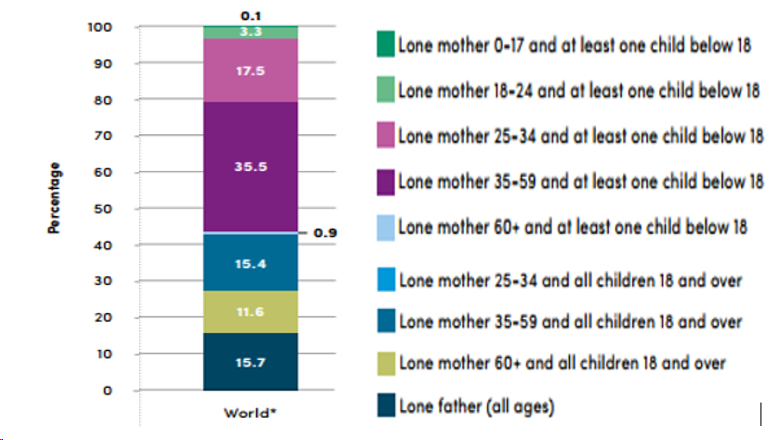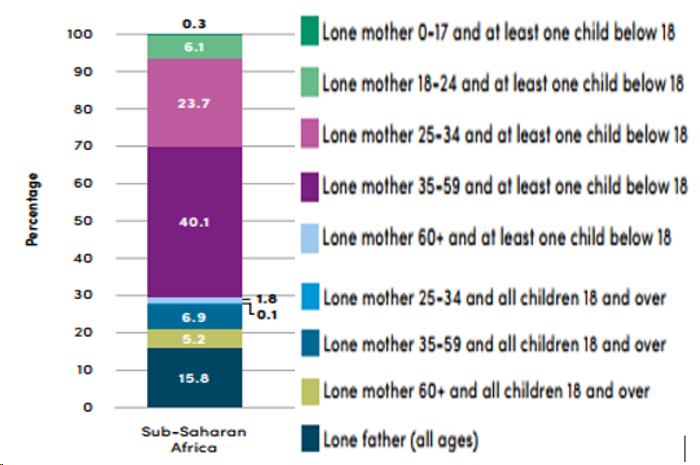By
Njang Ndenge Myrian
Ph.D Reseaarch Fellow, MSUI,Cameroon
ABSTRACT
The politico-economic and social distresses that have plagued Cameroon in recent years, have inadvertently contributed to the increase inthe numbers of Solo mothers making them a highly vulnerable cluster of women.As their situation and circumstances continue to gain complexity in the wake of the almost insurmountable socio political instances in Cameroon, there is need for an academic examination of the plight and perils of single mothers in an effort to inform policy. This paper thrusts on the causes and challenges of this cluster of women and suggest coping mechanisms or strategies that can enable them navigate through the odds. In other words, the paperseeks to diagnose the most pressing problems faced by Cameroonian single mothers, then propose a sustainable and replicable platform through which they can be empowered. Employing both qualitative and quantitative methods of data collection, the study uncovered that Single motherhood in Cameroon resulted mainly from abandonment by the father/husband, widowhood and divorce. The major problems faced by these single mothers were financial hardship, loneliness, depression and discrimination. Over 85 percent of Single mothers in Cameroon had no knowledge about legal provisions for their protection. Evaluating differences between the non-knowledgeable and theless than 16 percent knowledgeable solo mothersrevealed that level of education, occupation, ability to defend self and a belonging to an association of single mothers were significant variables. From these findings, prospects or a possible respite mode out of the plethora of threats to this institution isto galvanizefinancial empowerment, and other recommendations made to both the government and the civil society to address the problems of loneliness, depression, discrimination and the overall well-being of the Cameroonian single mothers.
Key Words:
Solo mothers, Challenges, Prospects, Cameroon, Civil society
Introduction
The family is the fundamental institution of organization in society and plays a very important role in the health and wellbeing of the society. Families provide the milieu where individuals are born, nurtured, learn to socialize and where the foundation of the individual’s behavior and views is laid, even though factors like globalization, economic boom, inequities vis-a-vis social determinants of health, urbanization, gender issues among others are influencing the traditional joint family norm (WHO, 2013). With the evolution of time, household structures have taken diverse forms depending on the nature of the environment, demographic trends, public policies, as well as social and cultural norms. Estimates revealed by the UN Women (2019) indicate that globally, approximately 38.4% of households are made of couples who live with children of any age, including adult offspring, 26.6% are couples with children plus other family members, 12.9% are couples without children, 12.5% are one-person households, 7.5% are lone-parent households and 2% are non-relative households.
Whatever the nature of the family, joint or nuclear, the WHO (2013) declares that it will continue to play a pivotal role in nurturing and socializing children, and influencing the development of adolescents, serving as a support structure for family members, influencing health, impacting behaviors both positive and negative, and providing opportunities and role models for healthy living. Unfortunately, it becomes a more demanding and often onerous task when the burden is left to only one of the parents (a concept known as single parenting), and the consequences remain inevitable. Several researchers have revealed that the worldwide trend of single parenting is rapidly on the rise, especially among women and young girls most likely aged between 25 and 59 years (Castro-Martín, 2010, 864; Heine, 2016, 1; Ali and Soomar, 2019, 1; UN Women, 2019, 63).
On a global scenario, the prevalence of single-parent households varies from one region to another. According to the UN Report, (2019, 41) and UN Women (2019, 63-64), 84.3% of lone-parent households are led by women, Single Motherhood. The Merriam-Webstar dictionary defines a single mother as “a mother who does not have a husband or partner” (nd).
Figure 1: World Distribution of Lone-parent Households by Age and Sex of Parent and Age of Child

Source: Extracted from UN Women, 2019, 64.
Comparatively, the subject of single parenthood has been better researched in the more developed countries than in the developing and underdeveloped countries. This attention is particularly negligible in Africa even though the population of women and men parenting alone is comparable and, in some cases, higher than what is obtainable in the more developed regions (Ntoimo and Mutanda, nd, 2).
Single-mother households, according to the 2019 UN Women report, are most common in Latin America and the Caribbean (9.5%), followed by the Sub-Saharan Africa (8.8%), Europe and Northern America (7.8%), Northern Africa and Western Asia (6.9%). In America, 80.5% of single parent households are headed by the mother (Snapchat of single mother families, 2020). All these rates are greater than or equal to the global average of 6.9%. On the other hand, Central/Southern Asia and Eastern/South-Eastern Asia register single-mother rates lower than the average global rate (4.9% and 5.0% respectively), probably due to economic barriers, cultural patterns of residence and social stigma attached to childbearing outside of marriage (p 63-64).
In Africa, single motherhood is prevalent in the sub-Saharan part. According to reports by Chadoka-Mutanda and Mbenafo (nd), findings from other studies in sub-Saharan Africa have indicated that single motherhood is common and an increasing family structure in some sub-Saharan Africa countries. Single mother households constitute 84.2% of single parent households in sub-Saharan Africa (UN Women, 2019, 64).
Figure 2: Distribution of Lone-parent Households by Age and Sex of Parent and Age of Child in Sub-Saharan Africa

Source: Extracted from UN Women, 2019, 64.
The Sub-Saharan Africa region is characterized by increasing rates of out-of-wedlock motherhood, marital instability, divorce and separation (with the women being given custody of the children in majority of the cases), high adult mortality as a result of the HIV/AIDS pandemic, labor migration mostly by the men (leaving their wives and children behind), an increasing proportion of never married women, and a decline in marriage rates as well as the proportion of those in marriage, among others (Ntoimo and Odimegwu, 2014, 2). Researchers have reported single motherhood in Sub-Saharan Africa to stand at about 27% in Congo Brazzaville, 53% in Namibia, 7.4% in Burkina Faso (Chadoka-Mutanda and Mbenafo, nd), 9.5% in Nigeria (Adewoyin et al., 2020, 4). Clark and Hamplová (nd) established that the total likelihood of ever being a single mother by the age of 45 was about 30.0% in Ethiopia, 59.5% in Kenya, 61.0% in Malawi, 51.7% in Tanzania, and 68.8% in Zimbabwe. The sub-Saharan Africa average is 10% (UN Women, 2019).
Single motherhood could result from widowhood, divorce, separation, migration of the male partner, abandonment, intimate partner violence, a quest for independence, premarital fertility, adoption, sexual violence, choice, social norms/laws that make it difficult for women to re-marry or enter a new union, or the abandonment of traditional family values and beliefs in religion, in marriage and the institution of the family (Heine, 2016, p. 1; UN Women, 2019, p.58, 63; Ali and Soomar, 2019, 1; Ntoimo and Mutanda, nd, 2; Clark and Hamplová, nd, 2-3).
Irrespective of the cause of single motherhood, with the increasing prevalence in sub-Saharan Africa and given the limited resources therein, there are bound to be negative effects on the overall wellbeing and the quality of life of both the mother(s) and the child(ren) under their care. Children growing up in single mother households face problems such as poor health, stunting, child mortality (especially under-5), poor academic performance which may lead to school dropout, negligible or reduced quality of care, Psychological instability (leading to violent tendencies, anxiety, depression, anger, isolation), improper social interaction, poor emotional and behavioral development, suicidal ideation and even lack of investment from the father. (Ali and Soomar, 2019, p. 2; Chadoka-Mutanda and Mbenafo, nd; Ntoimo and Odimegwu, 2014, 9). The mothers on their part are faced with challenges such as financial instability, stigmatization, discrimination, sexual and economic exploitation, loss of social status, unemployment or settlement for low-paying jobs, poor physical and mental health, depression (finding it difficult to build lasting new relationships), isolation, lower educational levels, violence in all its varied forms, among others (Heine, 2016, pp 1-2; Ali and Soomar, 2019, 1; UN Women, 2019, 47; Ntoimo and Mutanda, nd; Chadoka-Mutanda and Mbenafo, nd).
Interestingly, the more educated, enlightened, financially stable and economically independent single mothers (most of the time, single mothers by choice) are able to take very good care of themselves, their children and also surmount the difficulties elucidated supra, rather resulting in positive outcomes (Ntoimo and Odimegwu, 2014, 3), as opposed to the rural, uneducated and financially unstable women who are generally more vulnerable. Unlike countries in North America and Europe, Clark and Hamplova (nd) clearly state that most countries in sub-Saharan Africa lack welfare and social policies to protect vulnerable individuals from severe economic hardships. As a result, when women cannot provide adequate financial support on their own, they tend to rely on the generosity of their kin and social networks, and will usually resort to living with their families in order to cut down on expenses (house rents, utility bills, feeding, …) and also get support during difficult times. Public support is usually absent and where it is available, it is not enough to support single mothers and their families.
These problems are also specific to the case of Cameroon where the population of married women who were separated, divorced or had absent spouses increased from 78,060 in 1976 to 129,000 in 2005 (65%) and widows increased from 299,690 to 475,930 (58%) within the same period (Ntoimo and Odimegwu, 2014, 2).
Problem statement
This Study seeks to address the peculiar challenges solo mothers in Cameroon faced and to identify the prospects or strategies that can be engaged in synergy to mitigate or navigate through the plethora of challenges
Research objective
The main objective of this study is to identify the peculiar challenges of solo mothers in Cameroon and examine the strategies that have been put in place by various stakeholders to address them.
Research question
The main question for this research paper is what are the challenges of solo mothers in Cameroon and what strategies have been used to address the challenges?

